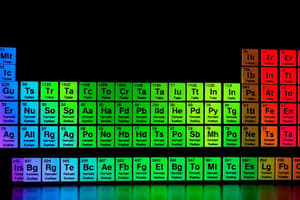Podcast
Questions and Answers
Which group of elements have ns1 electronic configuration?
Which group of elements have ns1 electronic configuration?
- Alkali Metals (correct)
- Halogens
- Transition Metals
- Noble Gases
Which element has the atomic number 11?
Which element has the atomic number 11?
- Potassium
- Sodium (correct)
- Lithium
- Rubidium
Which element has the electronic configuration [Ar]4s1?
Which element has the electronic configuration [Ar]4s1?
- Lithium
- Rubidium
- Sodium
- Potassium (correct)
Which element has the largest atomic size in its respective period?
Which element has the largest atomic size in its respective period?
Which group of elements exhibit +1 oxidation state?
Which group of elements exhibit +1 oxidation state?
Which group of elements are highly reactive metals?
Which group of elements are highly reactive metals?
Which element occurs only in traces as a radioactive decay product?
Which element occurs only in traces as a radioactive decay product?
Which group of elements have the electronic configuration [He]2s1?
Which group of elements have the electronic configuration [He]2s1?
Which element has the largest atomic size in its respective period?
Which element has the largest atomic size in its respective period?
Which element has the atomic number 19?
Which element has the atomic number 19?
Which element has the shortest half-life period?
Which element has the shortest half-life period?
Which element has the electronic configuration [Kr]5s1?
Which element has the electronic configuration [Kr]5s1?
Which element exhibits the largest atomic size in its respective period?
Which element exhibits the largest atomic size in its respective period?
Which group of elements lose electrons in s-orbitals?
Which group of elements lose electrons in s-orbitals?
Which group of elements have the largest atomic size?
Which group of elements have the largest atomic size?
Flashcards are hidden until you start studying
Study Notes
Electronic Configurations and Atomic Numbers
- Elements with ns1 electronic configuration belong to Group 1 (alkali metals).
- The element with atomic number 11 is Sodium (Na).
- The electronic configuration [Ar]4s1 refers to the element Potassium (K).
- The largest atomic size in its respective period is typically exhibited by alkali metals.
Oxidation States and Reactivity
- Elements exhibiting a +1 oxidation state are primarily found in Group 1 (alkali metals).
- Alkali metals are considered highly reactive metals, especially with water and halogens.
Radioactivity and Traces
- An element occurring only in traces as a radioactive decay product is often Radon (Rn) or Polonium (Po), depending on context.
More Electronic Configurations
- The group of elements with the electronic configuration [He]2s1 includes Lithium (Li), the first element in Group 1.
- The element with atomic number 19 is Potassium (K).
Atomic Size
- The element exhibiting the largest atomic size in its respective period among Group 1 elements is Cesium (Cs).
- Generally, alkali metals have the largest atomic sizes within their respective periods.
Half-Life Insights
- The element with the shortest half-life period is often Polonium-210, primarily known for its rapid decay.
Electron Behavior
- Elements in Group 1 (alkali metals) predominantly lose electrons located in their s-orbitals during chemical reactions.
Summary of Atomic Sizes
- Alkali metals are characterized by having the largest atomic size among all groups in the periodic table, attributed to their position and electronic configuration.
Studying That Suits You
Use AI to generate personalized quizzes and flashcards to suit your learning preferences.




